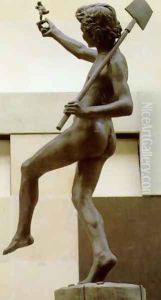Hypolyte-Alex-Andre-Julien Moulin Paintings
Hypolite-Alex-Andre-Julien Moulin, often known simply as Hippolyte Moulin, was a French sculptor born in Paris in 1832. He is known for his decorative sculpture works and his association with Orientalism, a movement that was prevalent in the 19th century among European artists. Orientalism was characterized by the depiction of Eastern cultures, particularly Middle Eastern, North African, and Asian, often romanticized and styled to fit Western tastes.
Moulin's work was part of a larger cultural phenomenon where artists sought to capture the allure of 'exotic' cultures through various forms of art including painting, sculpture, and architecture. His sculptures often depicted figures such as odalisques, dancers, and other figures inspired by his interpretation of the East.
Not much has been recorded about Moulin's early life or training. However, he began to gain recognition in the 1860s. Moulin exhibited his works at the Salon, the official art exhibition of the Académie des Beaux-Arts in Paris. His most notable period of activity was during the Second Empire (1852-1870) and the early years of the Third Republic until his death.
One of his well-known works is the bronze statue 'Pêcheur napolitain à la coquille', which translates to 'Neapolitan Fisher with Shell'. This work exemplifies Moulin's interest in the male form, imbued with a sense of the exotic, and illustrates his skill in capturing the sensuousness and vitality of his subjects.
Moulin's career was not without controversy. His sculpture titled 'L'Esclave affranchie' or 'The Emancipated Slave' received mixed reactions for its portrayal of a nude black woman breaking free from her chains. The work was seen as both a commentary on the abolition of slavery and an example of the eroticization of the female body, particularly of women of color, which was common in the Orientalist movement.
Despite enjoying success during his lifetime, Hippolyte Moulin's reputation did not endure as prominently as some of his contemporaries. He passed away in 1884, and over time, his name has become somewhat obscure in the annals of art history. Nevertheless, his sculptures are still of interest to those studying the Orientalist movement and 19th-century French art. Collectors and museums around the world that focus on this period continue to preserve and exhibit his works.
